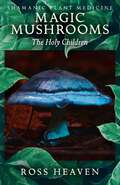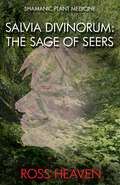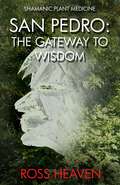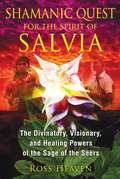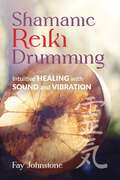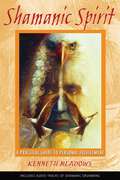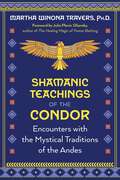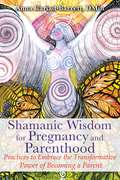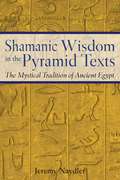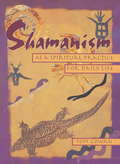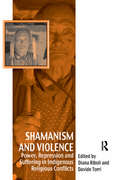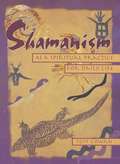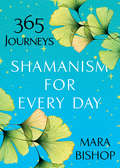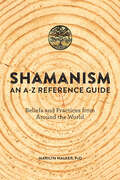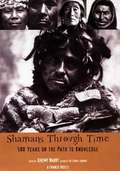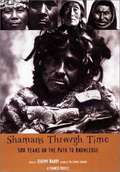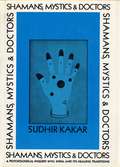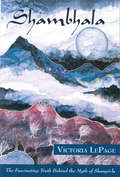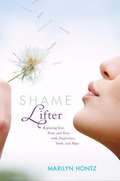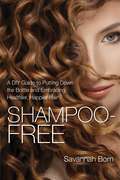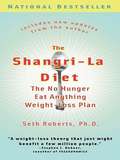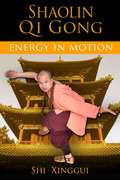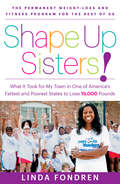- Table View
- List View
Shamanic Plant Medicine - Magic Mushrooms: The Holy Children
by Ross HeavenThe Shamanic Plant Medicine series acts as an introduction to specific teacher plants used by shamans in a variety of cultures to facilitate spirit communion, healing, divination and personal discovery, and which are increasingly known, used and respected in Western society by modern shamans as a means of connecting to spirit. Other books in the Shamanic Plant Medicine series include Ayahuasca: The Vine of Souls, Salvia Divinorum: The Sage of the Seers and San Pedro: The Gateway to Wisdom.
Shamanic Plant Medicine - Salvia Divinorum: The Sage of the Seers
by Ross HeavenThe Shamanic Plant Medicine series acts as an introduction to specific teacher plants used by shamans in a variety of cultures to facilitate spirit communion, healing, divination and personal discovery, and which are increasingly known, used and respected in Western society by modern shamans as a means of connecting to spirit. Salvia is the shamanic plant of Mexico. It is known particularly for its divinatory powers but it also has the ability to heal and, more extraordinarily, in modern usage it provides access to inter-dimensional travel and the ability to move through time. The shamanic applications of Salvia are currently little known outside of Mexico but, along with Ketamine and Ecstasy, it has become one of the most popular &‘drugs&’ on the planet among teenagers who have little or no understanding of how to use its powers in a positive and effective way or the potential dangers of using it recreationally. This book therefore serves as a much-needed introduction to this powerful plant.
Shamanic Plant Medicine - San Pedro: The Gateway to Wisdom
by Ross HeavenThe Shamanic Plant Medicine series acts as an introduction to specific teacher plants used by shamans in a variety of cultures to facilitate spirit communion, healing, divination and personal discovery, and which are increasingly known, used and respected in Western society by modern shamans as a means of connecting to spirit. Named after Saint Peter, the gatekeeper to Heaven, San Pedro is used by the shamans of the Andes in ways similar to ayahuasca and for similar reasons and effects. Its close relative, peyote, is employed by the shamans of Mexico and its modern chemical equivalent, Ecstasy, has become a popular rave culture means to trance and bliss states. Awareness of San Pedro is spreading rapidly in the West and the plant is likely to become more utilised than ayahuasca in the near future.
Shamanic Quest for the Spirit of Salvia: The Divinatory, Visionary, and Healing Powers of the Sage of the Seers
by Ross HeavenThe first practical guide to the transformative uses of salvia • Explains how salvia connects you with your higher purpose and aids you in envisioning your unique path in life • Describes appropriate methods of use, a shamanic diet to increase effectiveness, and the meaning of the symbols experienced during salvia’s ecstatic embrace • Explores recent clinical research into salvia’s long-term positive psychological effects and its potential as a treatment for Alzheimer’s, depression, and addiction Salvia divinorum has been used since ancient times by the Mazatec shamans of Mexico for divination, vision quests, and healing. Known by many names--nearly all associated with the Virgin Mary, who has come to symbolize the spirit of salvia--this plant ally is now regarded as the most powerful natural hallucinogen. Providing the first practical guide to the shamanic, spiritual, and therapeutic uses of salvia, Ross Heaven shares his in-depth quest to connect with the spirit of this plant teacher. He explores recent clinical research into its many long-term psychological effects, such as increased insight and self-confidence, improved mood and concentration, and feelings of calmness and connection with nature, as well as salvia’s potential for combating diseases like Alzheimer’s, depression, and even cocaine addiction. Reviewing the traditional Mazatec ceremonies surrounding salvia’s harvest and use, Heaven describes appropriate methods of consumption, typical dosages, and the shamanic diet he used to increase salvia’s effectiveness. Examining firsthand accounts of salvia journeys from around the world, he decodes the meaning of the symbolic images experienced during salvia’s ecstatic embrace and details the interplay between salvia and the lucid dreaming state. Comparing salvia to ayahuasca and the San Pedro cactus, Heaven explains that salvia’s greatest strength as a shamanic plant ally lies in its ability to connect you with your higher purpose and aid you in envisioning your unique path in life.
Shamanic Reiki Drumming: Intuitive Healing with Sound and Vibration
by Fay JohnstoneA complete guide to shamanic drumming for enhancing Reiki practice• Shares Reiki drum techniques and step-by-step shamanic practices to strengthen the potency of Reiki symbols and treatments and bring empowerment, healing, connection, and clarity to you and your clients • Looks at selecting a drum, attuning to its unique power, and how to use it for self-healing and for work with clients • Explains the essence of shamanic journeying with a drum, including how to set intentions, access and navigate the three shamanic worlds, meet spirit guides, and connect deeply with your intuition Advance your Reiki practice to the next level with vibrational sound healing and shamanism combined in the beat of the drum. In this guide, Reiki master and shamanic teacher Fay Johnstone explores in detail the practices and benefits of shamanic drum journeying in the context of Reiki healing. She shares Reiki drum techniques and step-by-step shamanic practices to bring empowerment, healing, connection, and clarity to you and your clients. She explains how the vibration of a drum enhances the efficacy of a treatment by inviting the client&’s energy field back to its optimal vibration as well as inducing relaxation and the release of tension. She shows how drumming allows a Reiki practitioner to dive into shamanic journeying for deeper guidance and insight on a client, and she reveals how vibration and sound can strengthen the energetic potencies of Reiki symbols. Exploring the magic of the drum, the author explains the essence of shamanic journeying, including how to set intentions, access and navigate the three shamanic worlds, meet spirit guides, and connect deeply with your intuition. Outlining the protocols of drumming for yourself and others, she presents a shamanic Reiki treatment flow protocol for the basic structure of a session, whether in person or distant healing. Highlighting personal healing practices with the drum, the author details exercises that combine with Reiki self-care and shamanic journeying to release negative energy, reclaim power, shift mindset, and manifest goals. She offers simple practical exercises to restore connection to our true self through drumming with nature, exploring the cosmos, and honoring the ancestors. She also presents guidelines for conducting ceremony and holding drum circles or Reiki shares for group healing and shamanic journeying. Welcoming Reiki practitioners into the rhythm of the drum and the path of shamanism, this book will inspire you to journey deeper into the unseen web that connects us all.
Shamanic Spirit: A Practical Guide to Personal Fulfillment
by Kenneth MeadowsA guide to self-realization and reattunement with nature that utilizes the ancient shamanic wisdom of cultures from around the world • Focuses on the development of grounded spirituality based on the connections indigenous traditions have with nature • Contains 33 hands-on experiential exercises and 50 shamanic meditations • Written by the author of Earth Medicine and Shamanic Experience Those of us who live in the so-called “advanced” modern world have been educated to use our minds and encouraged to satisfy our physical needs. But in so doing, we have become isolated from the very essence of our existence as individuals--our own spirit. In Shamanic Spirit Kenneth Meadows introduces Shamanics, his spiritual science of living, which recognizes the primacy of the spirit and acknowledges that spirit is inherent in all living beings and life forms. Shamanics is a practical way of becoming aware of our multi-dimensional reality and using that awareness to cultivate and refine the spirit within. Using the symbolic structure of the Medicine Wheel--which helps us establish a sense of direction, extend perception, and examine relationships--Meadows presents 33 hands-on experiential exercises that help readers discover the truth about themselves. His approach also draws upon and integrates universal shamanic concepts from such regions as the Americas, Europe, the Middle East, India, China, and Polynesia to show readers how to release their dormant potentials, generate creativity, and meet the challenges of their lives with confidence and self-assurance.
Shamanic Teachings of the Condor: Encounters with the Mystical Traditions of the Andes
by Martha Winona Travers• Presents the teachings of revered Ecuadorian Kichwa elder Taita Alberto Taxo as vivid, experiential journeys• Details how to return to intimacy with Nature and the natural world through communicating with the elements• Shares Andean shamanic practices and ceremonies for opening the heart, expanding consciousness, and shamanic journeyingIn this deep dive into South American shamanism, Martha Winona Travers shares the teachings and practices she learned during her 22 years as an apprentice to revered Ecuadorian Kichwa elder, Taita Alberto Taxo.Presenting Taita Alberto&’s teachings as vivid, experiential journeys, Travers allows you to immerse yourself in his direct, heart-centered wisdom as if you, too, were one of his shamanic apprentices. You will learn the ancient mystical traditions of the Andes, traditions saved by the elders specifically for these times. These traditions of healing invite human beings to return to intimacy with Nature and the natural world, through initiating conversations with the elements including the fifth, spiritual element, the Ushai. You will learn about the delicate dance of the Eagle (the mind) and the Condor (the heart), including how to reestablish the path of the heart to help bring the overactive mind into balance, the key to embarking on powerful shamanic journeys. You will visit sacred waterfalls, travel high up the active volcano Cotopaxi to a mountain lake for ceremony, experience the sounds carried on the wind in the mountains, see the Condor flying, and sit at night around the fire, listening to stories and laughter.As you journey together with Taita Alberto, you will begin to sense the fifth element, Ushai, being activated as the potent energy of spiritual transformation awakens within you. By experiencing his profound mystical realizations through shamanic transmission, you will learn to express gratitude with each of the elements, leave behind those burdens you no longer need to carry, and discover how to fly higher in life.
Shamanic Wisdom for Pregnancy and Parenthood: Practices to Embrace the Transformative Power of Becoming a Parent
by Anna Cariad-BarrettA guide to consciously exploring and honoring the spiritual and emotional journey of becoming a parent • Provides tools and meditations to engage the sacred wisdom-keeper within and create personal shamanic medicine to support you and your family • Discusses the shamanic perspective on miscarriage, fertility issues, postpartum stress, blended families, and adoption as a form of birthing through the heart • Provides shamanic teachings and techniques for conception, each trimester of pregnancy, birth, and the postpartum period The journey into parenthood transforms us, whether our children are biological, adopted, in spirit, or not yet conceived. As we give birth through heart or body, we not only shape-shift into mothers and fathers, but also gain access to the deep inner well of spiritual wisdom that opens with initiation into parenthood. In this guide to consciously exploring the shamanic journey of pregnancy and parenthood, Anna Cariad-Barrett offers techniques and ceremonies to honor the transformation of becoming a parent and engage the sacred wisdom-keeper within. She provides tools and meditations to create personal shamanic medicine to support you and your family on this journey as well as connect with the wisdom of nature, expand your intuition, and explore altered states of consciousness. Restoring honor to the shadow side of parenthood, the author discusses the shamanic perspective on miscarriage, fertility, sexuality, postpartum stress and depression, blended families, and adoption as a form of birthing through the heart. She explains how to heal any deep psychic wounds from your birth family and transform negative beliefs you may hold about parenthood. She provides chapters on each trimester of pregnancy, offering specific teachings and techniques appropriate to each stage as well as conception, birth, and the postpartum period. Whether you are preparing to welcome your first child or seeking spiritual support for the multidimensional experience of being a parent, the author shows how to reclaim and reconnect all the experiences of parenthood and how, through this rite of passage, we give birth to our most authentic selves.
Shamanic Wisdom in the Pyramid Texts: The Mystical Tradition of Ancient Egypt
by Jeremy NaydlerA radical reinterpretation of the Pyramid Texts as shamanic mystical wisdom rather than funerary rituals• Reveals the mystical nature of Egyptian civilization denied by orthodox Egyptologists• Examines the similarity between the pharaoh’s afterlife voyage and shamanic journeying• Shows shamanism to be the foundation of the Egyptian mystical traditionTo the Greek philosophers and other peoples of the ancient world, Egypt was regarded as the home of a profound mystical wisdom. While there are many today who still share that view, the consensus of most Egyptologists is that no evidence exists that Egypt possessed any mystical tradition whatsoever. Jeremy Naydler’s radical reinterpretation of the Pyramid Texts--the earliest body of religious literature to have survived from ancient Egypt--places these documents into the ritual context in which they belong.Until now, the Pyramid Texts have been viewed primarily as royal funerary texts that were used in the liturgy of the dead pharaoh or to aid him in his afterlife journey. This emphasis on funerary interpretation has served only to externalize what were actually experiences of the living, not the dead, king. In order to understand the character and significance of the extreme psychological states the pharaoh experienced--states often involving perilous encounters with alternate realities--we need to approach them as spiritual and religious phenomena that reveal the extraordinary possibilities of human consciousness. It is the shamanic spiritual tradition, argues Naydler, that is the undercurrent of the Pyramid Texts and that holds the key to understanding both the true nature of these experiences and the basis of ancient Egyptian mysticism.
Shamanism As a Spiritual Practice for Daily Life
by Tom Cowan Thomas Dale CowanThis inspirational book blends elements of shamanism with inherited traditions and contemporary religious commitments. Drawing on shamanic practices from the world over, SHAMANISM AS A SPIRITUAL PRACTICE FOR DAILY LIFE addresses the needs of contemporary people who yearn to deepen their own innate mystical sensibilities. This inspirational book shows how to develop a personal spiritual practice by blending elements of shamanism with inherited traditions and current religious commitments. Contents include:The central role of power animals and spirit teachers. Visionary techniques for exploring the extraordinary in everyday life. Elements of childhood spirituality including songs, secret hiding places, power spots, and imaginary power figures. A journey to an ancestral shaman to recover lost knowledge.
Shamanism and Violence: Power, Repression and Suffering in Indigenous Religious Conflicts (Vitality Of Indigenous Religions Ser.)
by Davide TorriProposing a new theoretical framework, this book explores Shamanism’s links with violence from a global perspective. Contributors, renowned anthropologists and authorities in the field, draw on their research in Mongolia, China, Korea, Malaysia, Nepal, India, Siberia, America, Papua New Guinea, Taiwan to investigate how indigenous shamanic cultures dealt, and are still dealing with, varying degrees of internal and external violence. During ceremonies shamans act like hunters and warriors, dealing with many states related to violence, such as collective and individual suffering, attack, conflict and antagonism. Indigenous religious complexes are often called to respond to direct and indirect competition with more established cultural and religious traditions which undermine the sociocultural structure, the sense of identity and the state of well-being of many indigenous groups. This book explores a more sensitive vision of shamanism, closer to the emic views of many indigenous groups.
Shamanism as a Spiritual Practice for Daily Life
by Tom CowanThis inspirational book blends elements of shamanism with inherited traditions and contemporary religious commitments. Drawing on shamanic practices from the world over, SHAMANISM AS A SPIRITUAL PRACTICE FOR DAILY LIFE addresses the needs of contemporary people who yearn to deepen their own innate mystical sensibilities. This inspirational book shows how to develop a personal spiritual practice by blending elements of shamanism with inherited traditions and current religious commitments. Contents include:The central role of power animals and spirit teachers. Visionary techniques for exploring the extraordinary in everyday life. Elements of childhood spirituality including songs, secret hiding places, power spots, and imaginary power figures. A journey to an ancestral shaman to recover lost knowledge.
Shamanism for Every Day: 365 Journeys
by Mara BishopDISCOVER YOUR UNIQUE PATH For thousands of years, practitioners of shamanism have found healing and wisdom by connecting to their own spirits and the spirit that lives in all things. Shamanism can be practiced by anyone. Wherever we are, the powers wihtin the web of life and the keys to our personal evolution are available. In these pages, longtime shamanic practitioner and intuitive consultant Mara Bishop introduces the simple yet profound method of shamanic journeying. On this path you will: · Connect to your innate knowing, for calm and confidence in intense times. · Develop meaningful relationships with nature for healing and guidance. · Explore spiritual realms with the aid of compassionate spirits. · Learn to manifest your goals and visions through ceremony. With 365 unique journey topics that can be used in any order, or as meditations, SHAMANISM FOR EVERY DAY offers an invaluable guide to anyone searching for a daily connection to the sacred.
Shamanism: An A-Z Reference Guide
by Marilyn Walker PhDDiscover the history and core elements of Shamanism Shamanism is a widely used term for a broad range of spiritual practices across time, continents, and cultures. Shamanism is your all-in-one reference guide to shamanic traditions and healing modalities around the world. Entertaining and easy to navigate, Shamanism is a rich collection of unique facts and stories from shamanic cultures. You'll find engaging entries on cultural beliefs, spiritual motifs, sacred objects, and rituals, like Vibrational Medicine and Soul Retrieval (recovering lost souls or soul parts). Shamanism includes: Shamanic handbook—Explore the history and mythology of Shamanic cultures, as well as engaging info on spiritual ecology or the back-to-nature movement. All about rituals—Learn about numerous rituals and techniques, like healing with crystals and extracting malevolent spirits with a Soul Catcher. Animism to Zoroastrian—This guide is organized alphabetically for easy reference so you can build your knowledge on the go. Discover the magic, mythology, and healing history of Shamanism with this introductory guide.
Shamans Through Time
by Jeremy NarbyA survey of five centuries of writings on the world's great shamans-the tricksters, sorcerers, conjurers, and healers who have fascinated observers for centuries. This collection of essays traces Western civilization's struggle to interpret and understand the ancient knowledge of cultures that revere magic men and women-individuals with the power to summon spirits. As written by priests, explorers, adventurers, natural historians, and anthropologists, the pieces express the wonder of strangers in new worlds. Who were these extraordinary magic-makers who imitated the sounds of animals in the night, or drank tobacco juice through funnels, or wore collars filled with stinging ants? Shamans Through Time is a rare chronicle of changing attitudes toward that which is strange and unfamiliar. With essays by such acclaimed thinkers as Claude Lévi-Strauss, Black Elk, Carlos Castaneda, and Frank Boas, it provides an awesome glimpse into the incredible shamanic practices of cultures around the world. .
Shamans Through Time: 500 Years on the Path to Knowledge
by Jeremy Narby Francis HuxleyThis collection of essays traces Western civilization's struggle to interpret and understand the ancient knowledge of cultures that revere magic men and women-individuals with the power to summon spirits. These writings by priests, explorers, adventurers, natural historians, and anthropologists express the wonder of strangers in new worlds. Who were these extraordinary people, men who imitated the sounds of animals in the night, or drank tobacco juice through funnels, or wore collars filled with stinging ants?Shamans Through Time is a rare chronicle of changing attitudes toward that which is strange and unfamiliar. With essays by such acclaimed thinkers as Claude LÉvi-Strauss, Black Elk, Carlos Castaneda, and Franz Boas, it provides an awesome glimpse into the incredible shamanic practices of cultures around the world.
Shamans and Robots: On Ritual, the Placebo Effect, and Artificial Consciousness (Univocal)
by Roger BartraA profound exploration of the external influences that shape human consciousness, from healing rituals to digital devices In this voyage through thousands of years of psychosomatic healing, distinguished anthropologist and sociologist Roger Bartra examines the placebo effect as a key to our understanding of human consciousness. Shamans and Robots demonstrates how biology and technology become intertwined within human culture by using the various histories of ritual and symbolic healing to speculate about future developments in artificial intelligence. Charting the extensive history of the placebo effect through medieval healing, shamanism, and early psychoanalytic practices, Bartra posits that consciousness is not simply the province of the mind but something equally shaped by external systems and objects. He finds evidence of this &“exocerebrum&”—the extension of our brains outside the body—in the shamanistic concept of the placebo, in which external objects heal our bodies, and in modern technical devices like prostheses or robots, whose development of a mechanical consciousness would have to mimic, and in turn elucidate, the processes involved in the creation of consciousness in humans. Through this radical concept, he analyzes digital media&’s relationship to the functions of the human brain and probes the possibility of artificial consciousness. Both a look at the human body&’s potential to restore itself and a profound reflection on the curative power of symbolic structures, Shamans and Robots explores how our technologies increasingly serve as extensions of our cognitive selves.
Shamans, Mystics, and Doctors: A Psychological Inquiry into India and Its Healing Traditions
by Sudhir KakarSudhir Kakar, a psychoanalyst and scholar, brilliantly illuminates the ancient healing traditions of India embodied in the rituals of shamans, the teachings of gurus, and the precepts of the school of medicine known as Ayurveda. "With extraordinary sympathy, open-mindedness, and insight Sudhir Kakar has drawn from both his Eastern and Western backgrounds to show how the gulf that divides native healer from Western psychiatrist can be spanned. "—Rosemary Dinnage,New York Review of Books "Each chapter describes the geographical and cultural context within which the healers work, their unique approach to healing mental illness, and . . . the philosophical and religious underpinnings of their theories compared with psychoanalytical theory. "—Choice
Shambhala
by Victoria LepageFor thousands of years, stories have been told about an inaccessible garden paradise hidden among the icy peaks and secluded valleys of the Himalayas. Called by some Shangri-la, this mythical kingdom, where the pure at heart live forever among jewel lakes, wish-fulfilling trees, and speaking stones, has fired the imagination of both actual explorers and mystical travelers to the inner realms.In this fascinating look behind the myth, Victoria LePage traces the links between this legendary Utopia and the mythologies of the world. Shambhala, LePage argues persuasively, is "real" and may be becoming more so as human beings as a species learn increasingly to perceive dimensions of reality that have been concealed for millennia.
Shambhala
by Victoria LepageFor thousands of years, stories have been told about an inaccessible garden paradise hidden among the icy peaks and secluded valleys of the Himalayas. Called by some Shangri-la, this mythical kingdom, where the pure at heart live forever among jewel lakes, wish-fulfilling trees, and speaking stones, has fired the imagination of both actual explorers and mystical travelers to the inner realms. In this fascinating look behind the myth, Victoria LePage traces the links between this legendary Utopia and the mythologies of the world. Shambhala, LePage argues persuasively, is "real" and may be becoming more so as human beings as a species learn increasingly to perceive dimensions of reality that have been concealed for millennia.
Shame Lifter: Replacing Your Fears and Tears with Forgiveness, Truth, and Hope
by Marilyn HontzDo you ever berate yourself over minor happenings? Do you feel unworthy and wonder why God would love you? Do you struggle to overcome memories of verbal, emotional, or physical abuse? If so, you may be suffering from unhealthy shame which, if not corrected, can produce bitterness and negativity in your life. From the author of the acclaimed book Listening for God comes the life-transforming book Shame Lifter, based on author Marilyn Hontz's personal story of releasing her own shame and embarking instead on a life of freedom, forgiveness, and truth.
Shampoo-Free: A DIY Guide to Putting Down the Bottle and Embracing Healthier, Happier Hair
by Savannah BornLearn about the hot beauty trend that's changing the way we think about our hair--and improving the way it looks--in the first-ever book about the shampoo-free movement. Parabens, sulfates, methylparaben, sodium laureth sulphate . . . yuck. Join the growing movement of women and men everywhere who are ditching their expensive addiction to chemical-laden shampoos and going shampoo-free. At first the idea of going shampoo-free might seem radical, or even a little icky, but this beauty secret--that's long had a cult following online and been featured in the New York Times, Marie Claire, Elle, and elsewhere--is gaining traction big time. Whether you're interested in saving money, saving the planet, or simply curious about how and why going shampoo-free can make your hair the healthiest, shiniest, fullest, and softest it's ever been, Shampoo-Free is the first-ever book to compile all the science, testimonials, instructions, and tips in one comprehensive guide. Shampoo-free enthusiast Savannah Born walks readers through how they can create their own simple and affordable solutions to keep hair clean and fresh without harsh chemicals. She offers encouragement and tips about how to survive the transition, and helpful illustrations make this the perfect one-stop guide.
Shangri-La Diet, The
by Seth RobertsSeth Roberts - a psychology professor at the University of California, Berkeley - experimented with a whole range of diets before arriving at one which not only worked extraordinarily well, but took the least amount of effort and willpower, and worked without deprivation. Based on the principle that you have a weight set-point, which you eat to until you no longer feel hungry, Seth recommends that you have a regular tablespoonful of light olive oil or sugared water between meals to lower your set-point, lower your hunger - and therefore lower your weight. No calorie counting, no change of diet - and no hunger. It's that simple!
Shaolin Qi Gong: Energy in Motion
by Shi XingguiAuthentic qi gong as practiced in the Shaolin Temple where this discipline originated centuries ago • Reveals the fundamental spiritual principles and includes both a short and long form of the daily exercises• Explains the benefits of mastering energy in the body, such as organ strengtheningThe great teacher Bodhidharma is credited with the creation of Shaolin Temple qi gong and kung fu in the 6th century CE. Motivated by the terrible physical condition of the monks who spent all their time meditating or copying scrolls, his two-part system promoted physical as well as spiritual fitness and became the basis for all the martial and meditative arts taught in the Shaolin Temple. These ancient practices increase physical health and vitality, enhance creativity, and can be practiced well into old age.Author Shi Xinggui, a Shaolin monk, explains the fundamental principle of qi gong--the art of mastering energy (qi) and moving it through the body--and provides clear demonstrations of all the positions and movements. In order to develop qi attentively, it is necessary to cultivate the art of slowness in both movement and breathwork. Shi Xinggui provides both a short form and a long form of the daily exercises, with lessons on heart centering, organ strengthening, and balancing the energy using the three dantians--the three energy centers of the body.
Shape Up Sisters!: What It Took for My Town in One of America's Fattest and Poorest States to Lose 15,000 Pounds
by Linda FondrenLinda Fondren, one of 11 children born to a single mother in the poorest and fattest state in America, watched the consequences of obesity ruin her sister's life—and was motivated to open an all-female gym in her hometown of Vicksburg, MS, with the motto "positively reshaping women." Then, witnessing how many middle- and low-income Vicksburg residents were brought up short in their fitness and health efforts by limited budgets, time, and access to resources, Fondren responded by striking at the root problem. In 2009, she spearheaded Shape Up Vicksburg, a City Hall–supported program in which she convinced the local hospital to offer free health screenings, restaurants to create healthy low-cal menu options, and Walmart to host weigh-in stations. Fondren signed up more than 2,500 Vicksburg residents to take charge of their health and nutrition—many of them for the first time. They lost more than 15,000 pounds.Shape Up Sisters! is a get-healthy prescription for regular people with jobs, budgets, and real-life challenges. Fondren offers tactics to incorporate exercise into daily activities, delicious recipes and menus to for eating healthfully on a budget, and motivation for a major attitude shift. She wraps it all in her empowering personal story and the uplifting tales of women who have changed their lives by following her simple strategies.With Fondren's approachable personality and practical advice, Shape Up Sisters! is both an easy-to-use guide and a bold statement in the greater national narrative about improving health and weight loss across socioeconomic lines.
